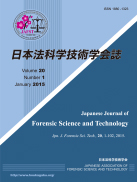Volume 20, Issue 1
Displaying 1-8 of 8 articles from this issue
- |<
- <
- 1
- >
- >|
Original Article
-
2015 Volume 20 Issue 1 Pages 1-14
Published: 2015
Released on J-STAGE: February 10, 2015
Advance online publication: October 31, 2014Download PDF (841K) -
2015 Volume 20 Issue 1 Pages 15-40
Published: 2015
Released on J-STAGE: February 10, 2015
Advance online publication: November 07, 2014Download PDF (1565K) -
2015 Volume 20 Issue 1 Pages 41-50
Published: 2015
Released on J-STAGE: February 10, 2015
Advance online publication: December 11, 2014Download PDF (351K)
Technical Note
-
2015 Volume 20 Issue 1 Pages 51-58
Published: 2015
Released on J-STAGE: February 10, 2015
Advance online publication: October 08, 2014Download PDF (772K) -
2015 Volume 20 Issue 1 Pages 59-67
Published: 2015
Released on J-STAGE: February 10, 2015
Advance online publication: October 31, 2014Download PDF (310K) -
2015 Volume 20 Issue 1 Pages 69-81
Published: 2015
Released on J-STAGE: February 10, 2015
Advance online publication: December 11, 2014Download PDF (1296K) -
2015 Volume 20 Issue 1 Pages 83-92
Published: 2015
Released on J-STAGE: February 10, 2015
Advance online publication: December 11, 2014Download PDF (849K)
Case Report
-
2015 Volume 20 Issue 1 Pages 93-102
Published: 2015
Released on J-STAGE: February 10, 2015
Advance online publication: October 31, 2014Download PDF (1335K)
- |<
- <
- 1
- >
- >|
